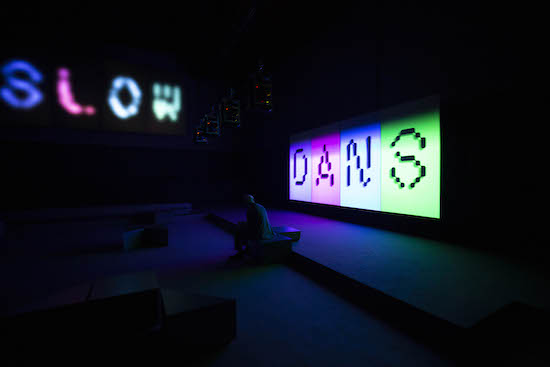The films of Elizabeth Price are complex, playfully and intricately layered, and visually and aurally arresting. The three films presented by Artangel under the umbrella title Slow Dans, are tightly choreographed and timed to play in sequence. Kohl, presented as a landscape triptych, is the first; the second is Felt Tip, with its vertically arranged screens; and the last is The Teacher, on the biggest screen.
These three works, with their slowly changing holding images and animations, are arranged on three walls of a nineteenth century assembly room, which is reached via a winding staircase. Altar-like, The Teachers faces the viewer as they enter the darkened space with its high ceiling and mezzanine floor. The intriguing Rorschach images on the huge screen resemble high-priestesses: hooded ‘figures’ in layers of fitted drapery, these elongated and digitally distorted bodiless apparitions have actually been drawn from high-end fashion magazines. The images on the other two screens are similarly de-familiarised: on one we see gently moving plant fronds, though scrutinising the image further, perhaps these are strings of bunting. Leached of colour and texture, they carry a checkered grey and black pattern, like the design on, say, a man’s tie. Then there’s the corner of an office, with the computer hardware in close-up taking on an almost coolly sinister aspect in its highly digitised, cinematic transformation.
The seductive slickness of Price’s films is striking. In 2012 she won the Turner Prize, and for the exhibition showed the compelling and actually disturbing The Woolworths Choir of 1979, a 20-minute film whose three segments are linked by recurring images of hand gestures and the tight percussive sound of sharp finger-clicking. The hands of trapped victims of a 1979 fire in a Woolworths store in Manchester, helplessly flapping from a window filled with billowing smoke, are juxtaposed with the expressive hand gesturing of singers. Images and sounds echo and complement each other until we reach a pounding and hypnotic crescendo of hands, rhythmic clicking, singing and text.
The title Slow Dans alludes to this rhythmic choreography. Its meaning, of a ‘slow dance’ or ‘the last dance’, also touches on the eroticised elements of Felt Tip and how these have been upended. Observations, some trite but complicated by more fantastical associations, focus on the masculine tie as a phallic symbol, as well as its associations with professional status and class. But this gendered item has now been appropriated by female office workers, we’re told, with the apparent slang of ‘felt tip’ referring to the tie when worn by women. A felt tip itself has a soft, velvety nib, which could be suggestive of various sexualised associations. In Price’s fictionalised world, past and future, facts, half-facts and tall tales elide.
Meanwhile, the spelling of the installation’s title might also allude to themes in The Teachers, where language has been disrupted or lost altogether by a segment of society whose members were once highly regarded but no longer retain that regard. Academics in university departments, the so-called Teachers, have become voluntarily mute, either choosing to remain silent or are now reliant on ‘sibilant forms’ and ‘supra-glottal sounds’ instead of speech. These strange verbalisations have themselves become the subject of journalistic and academic study.

In Price’s futuristic fictions, in her haunted tales of post-industrial decline, specifically in Kohl (Kohl is a literal ghost story, the genre pulling us to a more concrete conception of the abstract and slippery discipline of hauntology, which Price’s work explores), and in her sociological observations of class and gender, there is much playfulness – her mordant wit finds her riffing with form, language and sound. It’s no surprise that Price used to be a musician – the musicality and aural rhythms of her work are as compelling and memorable as her image-making.
In the triptych Kohl, photographs of disused collieries are upturned and displayed as graphic images against striking pop colour backgrounds. We are told, by a narrator and a running type-written script, that the old mines are slowly filling with water. The underground shafts, connected by networks across old mining counties, are being flooded. Not only do they carry sounds and music (we learn that young people are putting on underground discos across this vast geographical space, playing pop sounds of the past, but “visitants” are emerging from this oily sea like “inky black spit”. These indeterminate, shape-shifting creatures are finding their way into wine cellars and into data mines. They have infiltrated our bourgeois, post-industrial landscape, most tellingly as a latent technological threat. It’s a threat that becomes inescapably present in Felt Tip.
Price’s films are so wonderfully packed, aesthetically seductive, and allusive yet slippery, that you may want to sit through each of them more than once. This would be recommended, though maybe more for their sensory enchantments than an expectation of trying to unpick them with exhaustive rigour, at least not immediately. As with The Woolworths Choir of 1979, this more immersive installation is disquietingly, and unforgettably, powerful.
Elizabeth Price: Slow Dance is at Artangel, London, until 25 October


